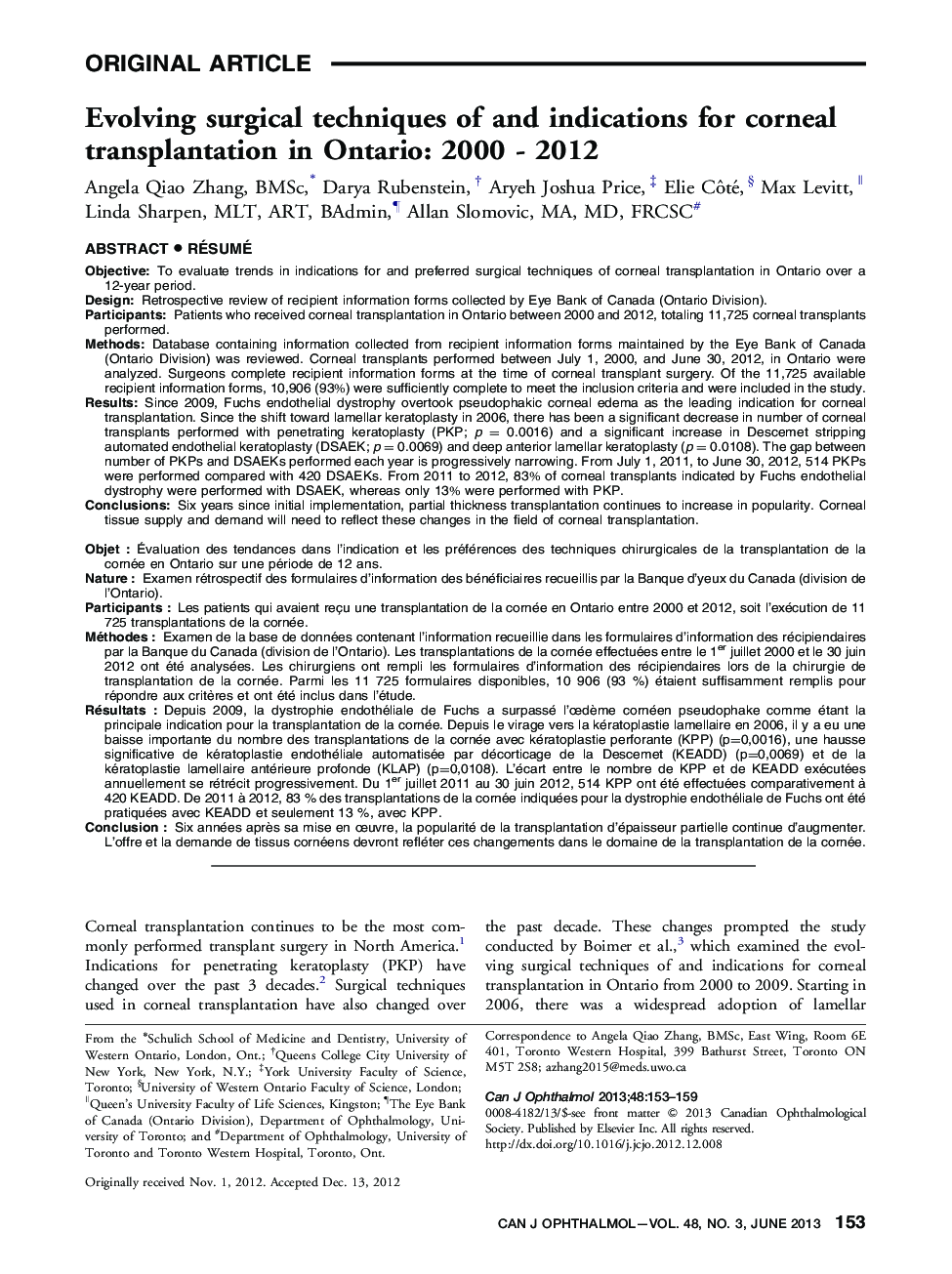| کد مقاله | کد نشریه | سال انتشار | مقاله انگلیسی | نسخه تمام متن |
|---|---|---|---|---|
| 4009749 | 1602409 | 2013 | 7 صفحه PDF | دانلود رایگان |

ObjectiveTo evaluate trends in indications for and preferred surgical techniques of corneal transplantation in Ontario over a 12-year period.DesignRetrospective review of recipient information forms collected by Eye Bank of Canada (Ontario Division).ParticipantsPatients who received corneal transplantation in Ontario between 2000 and 2012, totaling 11,725 corneal transplants performed.MethodsDatabase containing information collected from recipient information forms maintained by the Eye Bank of Canada (Ontario Division) was reviewed. Corneal transplants performed between July 1, 2000, and June 30, 2012, in Ontario were analyzed. Surgeons complete recipient information forms at the time of corneal transplant surgery. Of the 11,725 available recipient information forms, 10,906 (93%) were sufficiently complete to meet the inclusion criteria and were included in the study.ResultsSince 2009, Fuchs endothelial dystrophy overtook pseudophakic corneal edema as the leading indication for corneal transplantation. Since the shift toward lamellar keratoplasty in 2006, there has been a significant decrease in number of corneal transplants performed with penetrating keratoplasty (PKP; p = 0.0016) and a significant increase in Descemet stripping automated endothelial keratoplasty (DSAEK; p = 0.0069) and deep anterior lamellar keratoplasty (p = 0.0108). The gap between number of PKPs and DSAEKs performed each year is progressively narrowing. From July 1, 2011, to June 30, 2012, 514 PKPs were performed compared with 420 DSAEKs. From 2011 to 2012, 83% of corneal transplants indicated by Fuchs endothelial dystrophy were performed with DSAEK, whereas only 13% were performed with PKP.ConclusionsSix years since initial implementation, partial thickness transplantation continues to increase in popularity. Corneal tissue supply and demand will need to reflect these changes in the field of corneal transplantation.
RésuméObjetÉvaluation des tendances dans l'indication et les préférences des techniques chirurgicales de la transplantation de la cornée en Ontario sur une période de 12 ans.NatureExamen rétrospectif des formulaires d'information des bénéficiaires recueillis par la Banque d'yeux du Canada (division de l'Ontario).ParticipantsLes patients qui avaient reçu une transplantation de la cornée en Ontario entre 2000 et 2012, soit l'exécution de 11 725 transplantations de la cornée.MéthodesExamen de la base de données contenant l'information recueillie dans les formulaires d'information des récipiendaires par la Banque du Canada (division de l'Ontario). Les transplantations de la cornée effectuées entre le 1er juillet 2000 et le 30 juin 2012 ont été analysées. Les chirurgiens ont rempli les formulaires d'information des récipiendaires lors de la chirurgie de transplantation de la cornée. Parmi les 11 725 formulaires disponibles, 10 906 (93 %) étaient suffisamment remplis pour répondre aux critères et ont été inclus dans l'étude.RésultatsDepuis 2009, la dystrophie endothéliale de Fuchs a surpassé l'œdème cornéen pseudophake comme étant la principale indication pour la transplantation de la cornée. Depuis le virage vers la kératoplastie lamellaire en 2006, il y a eu une baisse importante du nombre des transplantations de la cornée avec kératoplastie perforante (KPP) (p=0,0016), une hausse significative de kératoplastie endothéliale automatisée par décorticage de la Descemet (KEADD) (p=0,0069) et de la kératoplastie lamellaire antérieure profonde (KLAP) (p=0,0108). L'écart entre le nombre de KPP et de KEADD exécutées annuellement se rétrécit progressivement. Du 1er juillet 2011 au 30 juin 2012, 514 KPP ont été effectuées comparativement à 420 KEADD. De 2011 à 2012, 83 % des transplantations de la cornée indiquées pour la dystrophie endothéliale de Fuchs ont été pratiquées avec KEADD et seulement 13 %, avec KPP.ConclusionSix années après sa mise en œuvre, la popularité de la transplantation d'épaisseur partielle continue d'augmenter. L'offre et la demande de tissus cornéens devront refléter ces changements dans le domaine de la transplantation de la cornée.
Journal: Canadian Journal of Ophthalmology / Journal Canadien d'Ophtalmologie - Volume 48, Issue 3, June 2013, Pages 153–159